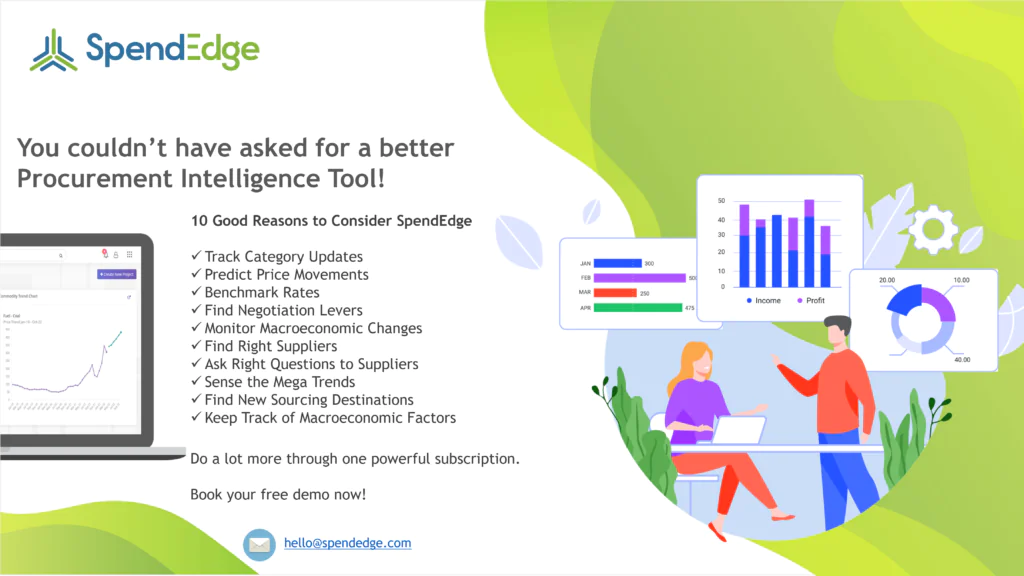Author: Associate Vice President, Sourcing and Procurement Intelligence
Table of content
- What Is Retail Inventory Management?
- Overview
- How does retail inventory management work?
- Effective inventory management techniques for the retail category
- How SpendEdge can help achieve efficient retail inventory management
- Success story: How SpendEdge helped a retailer with inventory management system implementation
What Is Retail Inventory Management?
Managing retail inventory involves making sure you have the right amount of merchandise that customers are interested in, neither having too little nor too much in stock. This way, retailers can fulfill customer demand without experiencing stockouts or having unnecessary excess inventory.
Overview
An important aspect of any retail business is to manage inventory is the most optimal manner. This means ensuring that neither too little nor too much stock is on hand. Optimally managing inventory helps retailers meet customer demand without running out of stock while simultaneously minimizing wastage by not carrying excess stock.
Effectively managing retail inventory helps reduce costs and obtain a proper understanding of sales patterns. Retail inventory management tools and methods give retailers important information with which they can optimally run their businesses. When implemented properly, it provides benefits such as lower inventory costs, reduced out-of-stocks, reduced spoilage and obsolescence, better multi-channel and omnichannel performance and order fulfillment, less shrinkage, improved supply chain management, and better forecasting of future sales, growth, and capital needs.
How does It Work?

1. Centralize your product records
Compile detailed product information in one place, including names, SKUs, brands, sizes, prices, categories, lot numbers, locations, expiration dates, vendors, vendor SKUs, wholesale costs, minimum reorder amounts, EOQ, case quantities, inventory levels, and reorder lead times. Add product images and descriptions for easy identification, especially for e-commerce. Regularly update records for any changes and establish clear inventory entry policies. Detailed data is crucial for maximizing the benefits of a retail inventory management system.
2. Track stock locations accurately
For single-store businesses, inventory locations are straightforward—typically on display or in the stockroom. For larger operations with multiple sites, inventory may be spread across warehouses, distribution centers, transit, stockrooms, and store shelves, with specific locations like sections, shelves, and racks. Misplaced items lead to missed sales and lost revenue. Implement retail inventory management practices using RFID tags, barcodes, and labels to automate inventory mapping.
3. Conduct regular and accurate inventory counts
Periodically count your inventory to maintain accuracy, considering shrinkage, damage, defects, and returns. Retail inventory management systems simplify this by focusing on data verification rather than starting from scratch, allowing attention to deviations. Count frequency depends on business complexity and the system used, but quarterly or annual counts are recommended. Methods include physical and cycle counting.
4. Integrate sales and inventory data for better reporting
A retail inventory management system can merge sales and inventory data, providing insights into sales velocity and identifying lagging products. Use this data to optimize reorder timing, quantities, and promotional strategies.
5. Develop a purchasing process
Schedule regular reviews of data and place orders to avoid seasonal trends and stock outages. Electronic systems can trigger reorder alerts at preset stock levels, including a buffer for continuous sales. Manual systems require reviewing items at reorder points to add to purchase lists. Prioritize purchases based on profitability, popularity, and lead time, and create purchase orders accordingly.
6. Plan for markdowns and promotions
Implement disciplined markdown and promotion strategies to clear slow-selling products, generate cash, and make room for profitable items. Plan promotions ahead to ensure adequate stock to meet demand.
7. Establish a stock-receiving procedure
Verify incoming orders and accurately enter goods into the inventory system to prevent stock outages, overpayment, and dead stock. Check deliveries against purchase orders, count cartons and pallets, and note discrepancies. Follow up with vendors on issues, enter new products into inventory, and store them properly. Consider adding price tags or barcodes. Perpetual inventory management involves counting goods as they arrive.
8. Create a return handling procedure
A defined process for handling customer returns reduces the risk of unsellable stock. Check returned items for damage or defects and route them for repair, write-off, or return to the vendor. Add sellable items to inventory counts and place them in their correct locations.
9. Implement a dead stock management process
Manage excess inventory, including damaged items, incorrect deliveries, and leftover seasonal products, to free up capital. Record and remove dead stock from inventory, designate a holding area, and handle it regularly. Return merchandise to vendors for credit promptly and note return deadlines. Return damaged goods to suppliers or follow their policies. Handle remaining items by selling to outlets, donating, recycling, or disposing of them.
10. Select key inventory KPIs
Track key performance indicators (KPIs) such as profitability, inventory value, sell-through rate, and turnover rate to measure process success. Learn to calculate these metrics and explore examples in an in-depth guide to KPIs for inventory management.
Effective Inventory Management Techniques for the Retail Category
Optimally order stock
Collaborate with suppliers
Up to date with latest technology
1. Optimally order stock
It is important for the success of a retail business that the ideal amount of stock is ordered at the right time. Inventory should be managed based on customer demand to ensure that the most demanded products are never out of stock. This can be achieved by setting data-backed levels for safety and par stock, analyzing reorder thresholds, optimizing order sizes with economic order quantity (EOQ) and using the open-to-buy technique to plan purchases. It is also important to track which products are the best and worst performers and understand indicators of customer demand and seasonal fluctuations and know the turnover rate and GMROI.
2. Collaborate with suppliers and vendors by being transparent
Another step that retailers should take to effectively manage inventory is to follow a collaborative approach with suppliers. It is important for retailers to be transparent and share sales and product forecasts with vendors so that lead times can be precisely determined. It is also important to monitor suppliers’ service levels such as the percentage of complete orders and fulfillment times and clearly communicate the areas where improvements are required the actions needed to achieve the improvement goals. In addition, retailers must also undertake contingency planning to identify alternative suppliers of the most important items for situations where the primary supplier cannot deliver.
3. Be up to date with latest technology offerings
Retailers must also look to leverage the latest available technology to optimally manage inventory. Technology can help in automating several tasks and instantly improve accuracy and efficiency of inventory management initiatives. The right tools can help retailers integrate point-of-sale (POS) system with inventory management, thereby eliminating the need to manually enter data, which will reduce errors and enhance the quality of data. Automated systems can also notify about reducing stocks and simplify the process of coordinating inventory in multiple locations. Technology can also be used to perform regular inventory audits and train staff, thereby improving the overall inventory management process.
How Can SpendEdge Help?
1. Analyze the available inventory management systems
SpendEdge’s seasoned analysts can help retailers understand even the most intricate details of various inventory management systems available in the market. In addition, our experience analyzing the operational and functional capabilities of companies providing these products ensures that only the best products and companies are shortlisted for retailers to choose from.
2. Adopt best practices from competitors
Considering the competitive nature of the retail business and how every dollar saved matters, it is important to have a close view of the inventory management processes being followed by peers. SpendEdge’s experts help retailers understand what their competitors are doing – which vendors they engage with, the engagement models being used, the KPIs they use to measure performance, and the SLAs included in the contract. Through a proper analysis of what other retailers are doing and industry standards related to measuring performance of suppliers, our analysts are able to provide the most pertinent best practices to successfully manage inventory and obtain cost reduction and cost avoidance.
3. Stay ahead of market trends
Through SpendEdge’s category updates service, retailers can gain insights on the most important developments in the inventory management systems market. This can help retailers preempt costly supply-side risks with timely issues and metric alerts. Advanced notifications provided by our experts help retailers minimize costs associated with demand/supply imbalances. Also, alerts on impending supply shortages due to factory shutdowns or issues with tier 2 suppliers can help retailers plan inventory better.
Success story: How SpendEdge Helped a Retailer with Inventory Management System Implementation
SpendEdge recently helped a US-based retail chain select the most optimal inventory management system based on their requirements. The client had a good understanding of the fast-moving categories and had effectively managed inventories at most of its stores across the country. However, it was witnessing increased stockouts for certain categories while overstocking for other categories. In addition, they were troubled with spoilage as well. The company wanted to check if they should change their inventory management system to improve outcomes since the contract with the existing vendor was due for renewal in less than three months.
SpendEdge’s team of experts did a thorough analysis of the capabilities of various inventory management systems available in the market. The features, cost and support provided for each of the systems were benchmarked. In addition, the most important SLAs to be included in the contract along with KPIs to determine the effectiveness of the system were provided to the client. Our insights helped the client to narrow down on a small set of suppliers who were invited to the RFx stage. Eventually the client changed its existing vendor and selected one from SpendEdge’s top 5 recommended vendors. In addition, the SLAs provided was used to create a watertight agreement.





